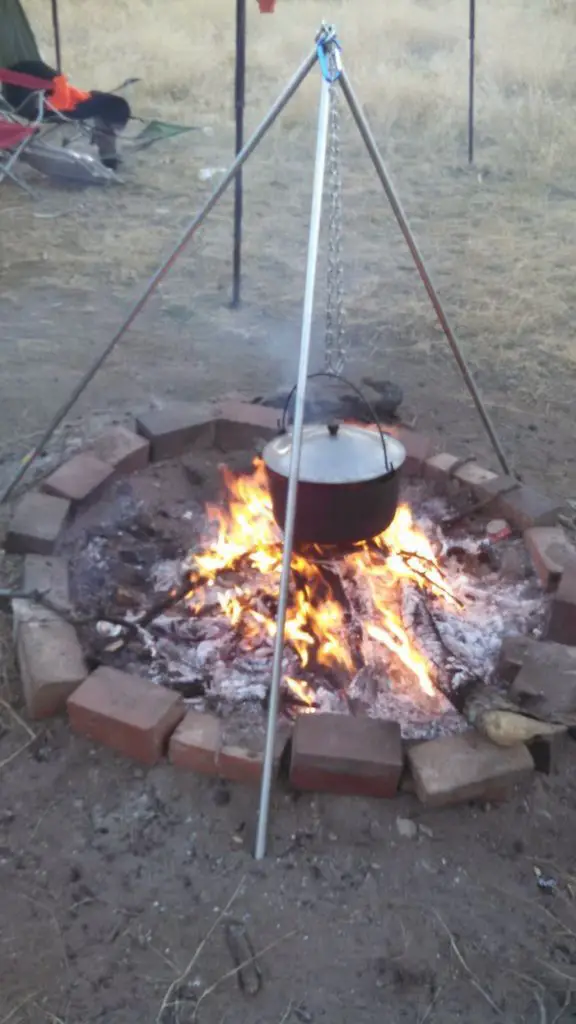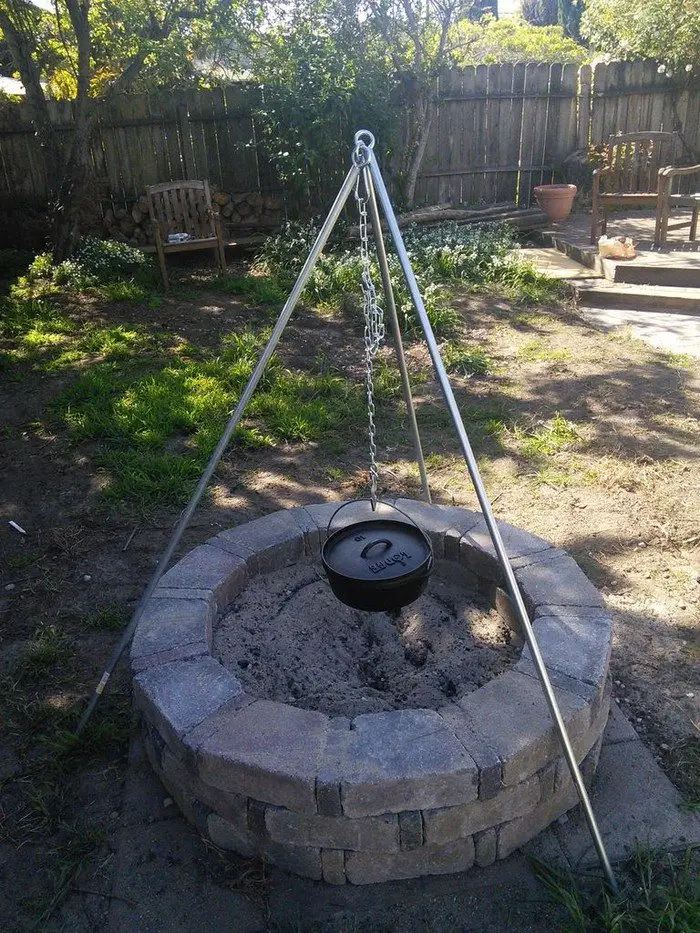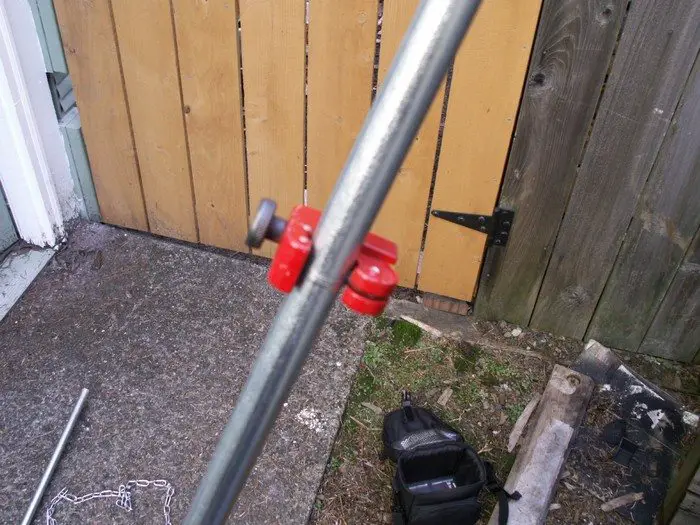If you love camping and need convenient campfire equipment that you can easily cook with and take with you, then a campfire tripod is a must-have for you!

Campfire tripods are sold in stores but sometimes they just don’t have the exact features that you’re looking for. The cheapest ones are usually short, while the longer ones are too heavy to bring around and more expensive too.
The good news is you can DIY one and customize it to meet your requirements for the perfect campfire tripod for you! This DIY campfire tripod will only cost you anywhere between $20 to $25 even if you buy brand new materials for it. You can cut it to whatever height you need it to be, which is great if you’re looking at using it for a big campfire or fitting it inside your vehicle. It’s also more lightweight compared to the wrought-iron version of it, which makes it more delightful to take with you on your camping trips.

It’s as good as the commercial campfire tripods, maybe even better if you build it right and well. You can hang your dutch oven or pots weighing 30 to a maximum of around 90 lbs on it. You can enjoy the convenience of it even when you’re roughing it outdoors!
Learn how to build your own campfire tripod and get ideas on how you can customize it to fit your cooking needs by following the step-by-step tutorial below!

Would you want this for your next camping trip?
Click on any image to start the lightbox display. Use your Esc key to close the lightbox.![]()






Contents
Building a Campfire Tripod
Materials
- 1/2″ Conduit (4′ long or longer; 3 sections)
- 3 Heavy-duty Eye Bolts
- 2 S-Hooks
- 4′ Chain (the kind with the wire links is great)
Tools
- Hammer
- Tubing Cutter or Hacksaw
- Pliers
- Wire Cutter
Steps

Cut the legs: First, cut the conduit to the desired length. I made mine 4’8″, but you can make them any length you like.
The tubing cutter has little rollers and a cutting wheel on a clamp. Tighten the clamp onto the conduit where you want the cut then tighten it down, turn, and repeat until the conduit is cut all the way through.
A hacksaw may also be used to do the job.
If you don’t have a way to cut the conduit, the hardware store may cut it for you when you buy it.

Open one eye bolt: Open one eye of one eye bolt using pliers, or lever it open with pliers and a scrap of tubing. This is the hardest part if you bought beefy eye bolts like these. It was probably overkill.

Assemble the eye bolts and chain: Now put the other two eyes and one end of the chain onto the open eye bolt. Use a hammer to reclose the open eye securely so it all stays together.

Connect the legs: Put the shafts of the eye bolts into the ends of the legs and stand it up with the legs equidistant, like it will look over a campfire. Put one of the S-hooks on the chain near the top and use the pliers to close it tight. This will be the adjuster for the cookpot height.

Cut the chain to length: Cut the chain to the desired length, using your cookware to measure the longest possible chain length desired.
It is long enough if the pot can sit on the ground and remain on the chain.
Put another S-hook onto the end of the chain and close with pliers.

Hang cookware: Hang your dutch oven, coffee pot, or whatever on the chain and make sure it will support its weight. Ensure the adjuster hook will get the cookware to the level you want.

Fold it up: The beauty of this design is that it can collapse easily for storage and transport.

Customize and enjoy: You can add lots of different useful features to this basic design. Add an extra hook to hang utensils, paint it with stove paint, make a mechanism to permanently connect the legs to the head, whatever you want.
Later on I am going to drill holes in two legs and add eye bolts to hold an additional piece of conduit from which I can hang more chains and hooks for more pots, or to hang boots for drying. (My brother-in-law has burned up two pairs of boots in as many hunting seasons because he puts them too close to the fire.)
The lower ends of the tripod should remain cool enough that you can pick up one leg at a time bare-handed to move it around a little bit. If you want to raise or lower the chain while it is hot, you might need oven mitts or a dutch oven lid lifter.
Thanks to pearsonry for this great project!
Safety Tips for Using a Campfire Tripod
By allowing you heat food straight over a campfire with stability and efficiency, a campfire tripod can really improve your outdoor cooking skills. However, following some particular safety rules will help to guarantee that everything runs safely and without incident. Using a campfire tripod calls for keeping these things in mind:
Choose a Safe Location
Choose a ground level, steady area for your campfire tripod. Make sure it is far from flammable objects like dry grass or overhanging limbs. To stop any unintentional fires, the area needs to be free of trash and properly ventilated.
Inspect the Campfire Tripod Before Use
Before you begin cooking, quickly once-over your campfire tripod. Look for any evidence of flaws or damage. Make sure the tripod can support your cookware’s weight without wobbling or collapsing and that all the connections are tight.
Stable Setup
Verify that your campfire tripod’s legs are firmly planted on the ground and fairly spaced out. You really want to avoid a shaky arrangement since it might cause dangerous spills or the tripod falling over.
Use Appropriate Cookware
Not every pot and pan are designed for cooking over a campfire. Select tools that complement your campfire tripod’s capacity and size. Oversized cookware tips are overly plentiful; thus, you should not take any chances.
Handle with Care
Remember, your campfire tripod gets rather hot when in use. When handling cookware or modifying the tripod, always wear heat-resistant gloves. Steer clear of shifting the tripod across the fire. Should you want to change it, wait until it cools down enough.
These safety guidelines will help you to ensure that your campfire cooking is not only enjoyable but also safe. In this sense, everyone can enjoy themselves worry-free.
Creative Uses for a Campfire Tripod Beyond Cooking
A campfire tripod is not just for cooking! This versatile piece of camping gear can be repurposed in several creative ways to enhance your camping experience. Whether you’re looking to simplify your campsite setup or add a touch of convenience to your outdoor adventure, a campfire tripod can come in handy for more than just heating up your dinner. Here are some innovative uses for a campfire tripod beyond its traditional cooking role:
Lantern Holder
As the sun sets and the campfire’s glow begins to fade, lighting becomes crucial in a campsite. A campfire tripod can serve as an excellent lantern holder. By attaching a hook to the top of the tripod or using an S-hook on the chain, you can hang a lantern to illuminate your campsite. This elevated position spreads light more evenly than placing it on the ground, making it perfect for lighting up a large area for socializing or late-night reading.
Drying Rack
After a day of hiking or if you get caught in a rain shower, you might find yourself with wet clothes or boots. The campfire tripod can be transformed into a convenient drying rack. Hang items from the S-hooks or attach additional lines between the legs to create a drying space. Position the tripod close enough to the fire to benefit from the heat but far enough away to avoid any risk of fire. This setup helps dry your gear faster, so you’re ready to go again the next morning.
Temporary Shelter or Tarp Support
In situations where you need a quick shelter from rain or dew, the campfire tripod can come to the rescue. By strategically placing the tripod and draping a tarp over it, you create an instant shelter or a makeshift tent. This can be particularly useful when you need a central support for a large tarp, providing a dry area for your group to gather under during sudden downpours.
Camera or Binocular Stand
The campfire tripod can also be used as a stable platform for cameras or binoculars for people who like observing animals or capturing the splendor of the surroundings. Adjust the legs to level the tripod on uneven ground. Then, use the hook system to fasten your gear at the proper height. When stability is essential for long-exposure shots or steady viewing, this repurposing is especially helpful early in the morning or late evening.
Outdoor Art Station
Should the great outdoors inspire you as an artist, your campfire tripod can turn into an art station. Attach a light-weight easel or board to one of the legs and hang supplies or a lantern using the hooks. From your campsite, this arrangement offers a strong, portable station ideal for painting, drawing, or writing that will help you to capture the scene.
Garden Trellis
The campfire tripod finds fresh life in your garden back home. For climbing plants including ivy, roses, or beans, use it as a trellis. Its strong construction promotes plant development, so enabling a charming and useful garden accent.
Investigating these artistic applications for a campfire tripod increases its value and demonstrates its indispensible nature for outdoor enthusiasts as well as for frequent campers. Your campfire tripod is a multifarious tool on any camping trip since, by thinking creatively, you can extend its usefulness much beyond its conventional use.
Conclusion
Beyond only cooking, a campfire tripod turns out to be a flexible and very useful tool improving your camping experience in many different ways. It is a must-have item in your outdoor gear collection since you maximize its value by using it for different other purposes. Any adventure enthusiast should definitely have a campfire tripod since of its flexibility and simplicity of use.
For more useful camping projects, check out our suitcase picnic table guide!





